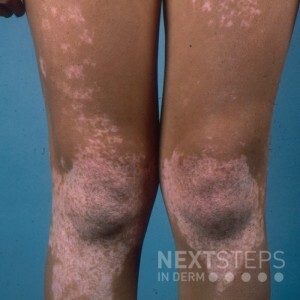
The correct answer is A. Autoimmune regulator (AIRE).
Autoimmune polyendocrinopathy-candidiasis–ectodermal dystrophy (APECED) syndrome is named for the clinical features of autoimmune polyendocrinopathy, candidiasis, and ectodermal dystrophy. It is caused by a mutation in AIRE (autoimmune regulator). Nearly 13% of these patients have vitiligo. APECED is also known as autoimmune polyglandular syndrome type 1 (APS1), autoimmune polyendocrine syndrome type 1, Whitaker syndrome, and candidiasis-hypoparathyroidism–Addison disease syndrome, among its many other names. APS1 is caused by gene mutations in the autoimmune regulator gene, AIRE, on chromosome 21q22. It is inherited in an autosomal recessive pattern (two copies of an abnormal gene must be present for the syndrome to develop). These gene mutations lead to autoantibodies and cause chronic inflammatory cell infiltrates in the affected organs.
PTEN gene mutation is associated with Cowden syndrome. TRP1 gene mutation is associated with oculocutaneous albinism type 3. FH gene mutation is associated with Reed syndrome. LYST gene mutation is associated with Chediak-Higashi syndrome.
References: Aldasouqi SA; Medscape. Type I polyglandular autoimmune syndrome. 2014. Available at: http://emedicine.medscape.com/article/124183-overview (accessed July 2016).
Genetics Home Reference, US National Library of Medicine. Autoimmune polyglandular syndrome, type 1. 2016. Available at: http://ghr.nlm.nih.gov/condition/autoimmune-polyglandular-syndrome-type-1 (accessed July 2016).
Betterle C, Greggio NA, Volpato M. Clinical review 93: Autoimmune polyglandular syndrome type 1. J Clin Endocrinol Metab 1998; 83: 1049–55. DOI: 10.1210/jcem.83.4.4682. Journal
Brought to you by our brand partner

